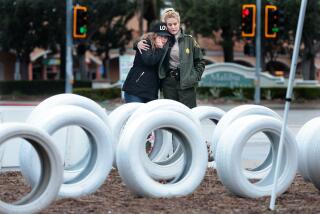Humps Brake Speeding Habit in Pasadena
- Share via
PASADENA — Motorcycles and cars used to race down Manzanita Avenue toward Brenner Park so fast that residents feared they would jump the curb and fly onto the park grounds.
On nearby Sunset Avenue, vehicles zoomed up to 50 m.p.h for three blocks from Mountain Street to Orange Grove Boulevard.
“Who knew why?” Pasadena resident Audrey Brantley said of the speeders. “We’re a residential area.”
But Brantley and her neighbors restored order to the two streets after they petitioned city officials to install speed humps. Now the three-inch humps every 300 feet keep most motorists well under the 25-m.p.h residential speed limit.
The humps are so effective that Brantley said she receives frequent calls from other Pasadena residents wanting to know how to get them installed.
The city is also receiving such calls. It was equipped 50 streets with 200 humps, and 35 more streets are in line for 150 more.
“Demand exploded,” said city traffic engineer David Barnhart. “This is the first year we’ve had eligible requests that exceeded funding. I’m not sure what’s going on out there.”
Faced with paying $90,000--three times the budgeted amount--to install new humps next year, the Pasadena Board of Directors decided to go ahead but told Barnhart to reevaluate the program before the city continues it next summer.
Pasadena’s plight is unusual. Although a handful of other Southern California cities experimented with speed humps in the early 1980s, none of them went on to develop a full-fledged program.
Santa Monica, Thousand Oaks, Brea and Claremont installed humps on a few streets, but the idea didn’t catch on. Residents objected, city council support was lacking, rules for installing the humps prohibited their widespread use and city engineers were reluctant to install a device not officially approved by the California Traffic Control Devices Committee.
As a result, only about a dozen humps remain in those cities. But Pasadena forged ahead.
Devised in Great Britain, speed humps are different from typical shopping-center speed bumps. Bumps are usually up to five inches high and slope for a foot or two. Humps are only three inches high and slope for 12 feet.
The more gradual slope keeps cars from screeching their brakes, banging into the hump, jolting passengers excessively and scarring the pavement when they come back down, Barnhart said, adding that humps are also more effective in reducing speed.
To get humps installed on a street that technically qualifies under the city program, at least 65% of the people who live on the street must sign a petition.
Barnhart said humps are catching on in Australia, where a trapezoid design with a flat top is being used to restrain rowdy drivers.
“I’ve spent most of my career trying to make roads smooth,” Barnhart said. “Now I’m putting bumps in them.”
More to Read
Sign up for Essential California
The most important California stories and recommendations in your inbox every morning.
You may occasionally receive promotional content from the Los Angeles Times.










